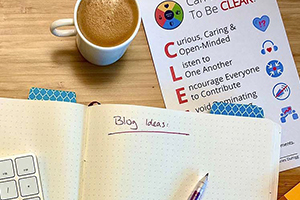Fluid Scaling Technology in 5 Sentences
A TL;DR introduction to Fluid Scaling Technology (FaST).
You can read more about FaST in the FaST Guide, but here’s a (very) simple
overview of the process.

1 - Bring everyone together to work as a Collective.
Remove dependencies on other teams, along with the need to manage skill sets across multiple teams, by combining them into a single Collective.
Managers no longer need to figure out how to share their lone UI/UX person across multiple teams. Dependencies on other teams and the waiting and communication issues that go with those dependencies go away when we are forming teams around work, instead of forming teams and giving them work.
2 - Throw your work on the wall.
Visually represent business goals and all the work in a place that is accessible to anyone who wants to see it. This could be a whiteboard, posters on the wall, or Discovery Trees. It could be on an online whiteboard or tool. Give access to everyone that wants to have access.
This doesn’t have to be a heavy process. This can be as simple as a Slack channel that hosts screenshots, or demo videos. It can be an online dashboard that shows system status, or a shared spreadsheet that shows the percentage done for each work item. The important thing is that it radiates information about the progress of the work.
3 - Have a meeting where the Collective self-organizes and self-selects into teams.
Each Value Cycle, the Collective comes together as a group to organize around “the next most important thing that the product doesn’t do.” They select the work for the next Value Cycle, create teams, and clarify direction and focus. In FaST, we use a modified Open-Space marketplace to encourage emergent leadership and team responsibility for work.
4 - Work.
Once organized, each team breaks down their work and discusses the steps to add value. This could include discussions
with the customers or other teams. Or it may be a time to clarify requirements or get feedback on architectural
direction. It is also the time for the team to come to an agreement on how they will work in this value cycle.
Then,
having come to a consensus and understanding, they “Go Forth and Do All the Things!”
5 - On a short cadence, meet back together to synchronize.
At the end of the Value Cycle, the Collective meets to discuss information relevant to the Collective and “Value Added” learnings and progress. The FaST guide recommends using a two day value cycle timeframe, this is not meant to be prescriptive. Value cycles can be adjusted to any length, although we advise getting rapid and regular feedback from the customer at very short intervals.
As the FaST guide says: “FAST is a flow system, not an iterative method, so Value Cycles are not time boxes to fit work into. There is no reason a Collective could not have a two-day cycle followed by a three-day cycle in a week should that be of appeal. A Collective needs to discover the shortest synchronization period that feels right.”




